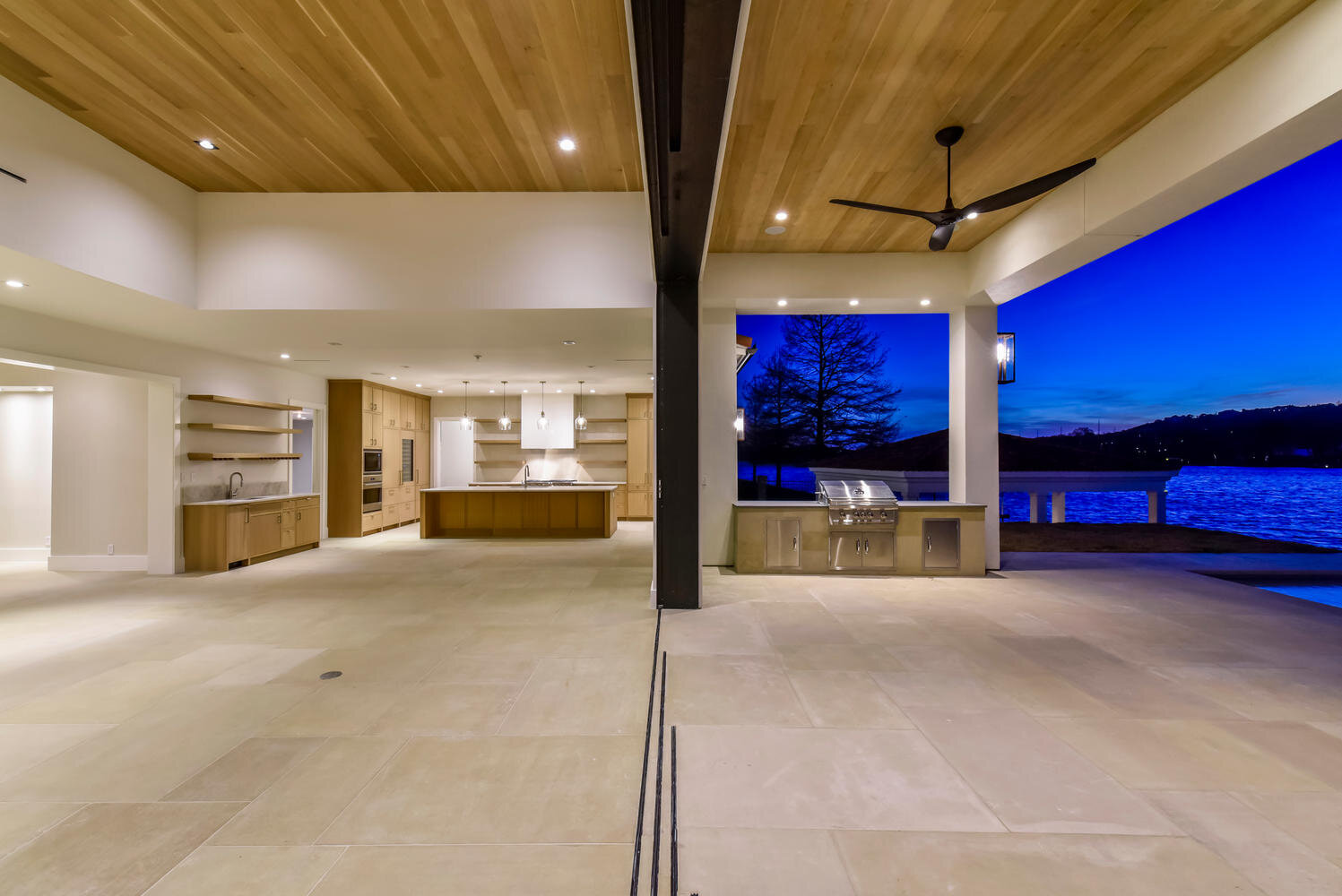Outdoor Kitchen Design: The Architect’s Guide to Building a Functional Outdoor Living Space
Outdoor kitchens are a great way to expand your living space and spend more time enjoying the outdoors. When designing and building an outdoor kitchen, it is important to consider functionality as well as regulations to ensure a space that works well and is safe to use. Our DK Studio architects in Austin, Texas are giving the complete guide to building the ultimate outdoor kitchen that offers function, flow, and style.
Watersedge, Remodel
Look at the Benefits of an Outdoor Kitchen
To start, our architects recommend looking at the benefits of adding an outdoor kitchen and what it can offer to your family. Here are our top 4 reasons for consideration.
1. Good for Entertaining
Creating an outdoor kitchen adds an additional entertaining space to your home. This is perfect for families who love having guests. When having large gatherings, outdoor spaces are often more accommodating and allow people to move about freely. It’s also a fun bonus to have summer BBQs by the pool.
2. Expands Liveable Space
With the addition of an outdoor kitchen, you basically create a second great room in the great outdoors! Indoor-outdoor living has gained popularity, and people enjoy spending time outside to disconnect and unwind. Having a kitchen space allows for outdoor meals and easy conveniences, like a fridge for drinks and a sink for cleaning up.
3. Increases Home Value
Outdoor kitchens are also a great investment in your home. Outdoor living spaces have become highly sought after and an existing outdoor kitchen could serve as a great incentive for future prospective buyers.
4. Keeps Cooking Odors Outside
If you’re a fan of grilling, an outdoor kitchen is a must. Preparing some foods inside the home can cause lingering odors for days. This is especially problematic for open concept homes where the kitchen is open to other spaces, like the living room. Outdoor kitchens offer the perfect space for grilling, cleaning fish, and tackling other tasty but potent meals.
Decide What You Need from Your Outdoor Kitchen
Once you have looked over the benefits of an outdoor kitchen and decided that it is a perfect addition, you will need to decide what functions you need your outdoor kitchen to perform. Architects use the architecture design process to meet with the homeowner and really hone in on how they need the space to function. For example, does your outdoor kitchen need to serve as a full kitchen, or does a wet bar more closely align to your needs. Sometimes the distance from the main kitchen plays a role in what is necessary to include in the outdoor kitchen. An architect will also be able to determine the best placement for flow and safety. An outdoor kitchen too close to the house could cause ventilation problems, and crowding could become a concern. The key is to make sure that upon completion the outdoor kitchen has everything you need to enjoy it, and that the space is utilized properly.
Make Sure Your Outdoor Kitchen Matches Your Home Style and Landscape
After determining what needs your outdoor kitchen must meet, it is time to consider materials that match the style of your home and landscape. If you are seeking to blend inside and out for indoor-outdoor living that flows, consider extending interior tile outside to your outdoor kitchen. For a traditional home, a pergola could be a good way to define the outdoor kitchen space. Where a modern home could utilize a polished concrete countertop that is both durable and fits a streamlined aesthetic.
Watersedge,Remodel
Choosing Outdoor Kitchen Materials and Appliances
Choosing outdoor kitchen materials and appliances differs from the choices you make for your indoor kitchen. Durability becomes a key factor because everything must not only perform but also withstand the weather. Here are some of our architects’ recommendations.
Appliances
Stainless steel is a necessity for durable outdoor appliances. Built-in grills are perfect for defining the space and creating a more cohesive feel. When adding additional appliances, like a fridge, it is good to make sure they have shelter from the elements.
Countertops
Outdoor counters need to be resistant. Concrete and granite are good options and should be sealed. Softer stones like soapstone tend to be too porous and will weather faster.
Cabinets
Outdoor kitchen storage is a must, so make sure not to overlook adding outdoor cabinets. Typically, it is a good idea to build in counter supports with brick or stone and to add durable cabinet fronts. Stainless steel, composite wood, and polymer cabinets are all good options that will stand up to outdoor conditions.
Additional Needs for Outdoor Living
Some of our clients have taken the opportunity to add amazing elements to their outdoor kitchens, like a pizza oven! Pizza ovens offer a fun cooking experience that not everyone can have access to inside. Placement of a feature like this is key, as it can get up to 900 degrees. Other clients have added fire pits, pools, and outdoor TV viewing areas, which create a full outdoor living experience.
Creating a Functional Outdoor Kitchen
Creating a functional outdoor kitchen can be tricky. Planning is important and you have to consider smoke, fire, and heat when deciding placement along with other utilities like electricity and water. Additionally, you need to ensure circulation with fans and make sure the space flows for the household. Would an island, peninsula, or bar be more efficient? Should there be a window passthrough to the main kitchen? An architect will be able to help design a space that is functional, beautiful, and enjoyable as well as guide you throughout the process. A space like this is truly the bridge from inside to outside and is perfect for living alfresco.
Do you need help with designing your great outdoors?


